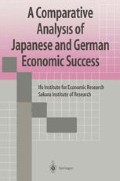Abstract
Almost fifteen years of continuous war, which started with the Manchurian Incident in 1931, followed by the war between China and Japan and the Pacific War (World War II), ended with Japan’s unconditional surrender to the Allied Forces and its acceptance of the Potsdam Declaration in August 1945, and resulted in the collapse of the Japanese Empire. Japan entered the post-war era with its economy totally crippled by the war. After a period of extreme confusion, Japan began to rise again from the ashes of war and subsequently achieved a miraculous reconstruction and development. In order to examine Japan’s post-war economic development, it is first necessary to ascertain the extent of human and material losses that Japan suffered in World War II and to evaluate the economic and social conditions that existed in the immediate post-war period.
Access this chapter
Tax calculation will be finalised at checkout
Purchases are for personal use only
Preview
Unable to display preview. Download preview PDF.
Bibliography
Literature to 2.1
Arisawa H (ed) (1994) The Showa-era history of the Japanese economy, vol 1 ( Showa Keizaishi Jou). Nihon Keizai Shinbun, Tokyo
Economic Planning Agency (ed) (1992) The postwar history of the Japanese economy, vol 1 (overview). (Sengo Keizaishi 1. Soukanhen), Toyo Shorin, Tokyo
Ishikawa H (1981) The postwar history of desire (Yokubouno Sengoshi). Taihei Shuppan-Sha, Tokyo
Ministry of International Trade and Industry (ed) (1991) History of trade and industrial policy, vol 2 (Tsuushou Sangyo Seisakushi Dai 2 Kan) Tuushou Sangyo Chousakai, Tokyo
Nakamura T (1978) The Japanese economy, 1st edn (Nihonkeizai Daisanhan). University of Tokyo Press, Tokyo
Japan Federation of Certified Public Tax Accountant’s Association (JFCPTA) (1987) Modern tax system series vol. 31 withholding tax (Gendai Zeimu Zensyu 31 Gensen no Zeimu). Gyousei, Tokyo
Noguchi Y (1995) The 1940 establishment (1940nen Taisei). Toyo Keizai Shinpo-Sha, Tokyo
Literature to 2.2
Abelshauser W (1975) Wirtschaft in Westdeutschland 1945–1948. Rekonstruktion und Wachstumsbedingungen in der amerikanischen und britischen Zone. DVA, Stuttgart
Buchheim C (1991) Die Währungsreform 1948 in Westdeutschland. München
DeLong B, Eichengreen B (1993) The Marshall Plan: History’s most successful structural adjustment Program. In: Dornbusch R, Nölling W, Layard R (eds) Postwar economic reconstruction and lessons for the East today. MIT Press, Cambridge, MA
Dumke RH. (1990) Reassessing the Wirtschaftswunder: Reconstruction and post-war growth in West Germany in an international context. Oxf Bull Econ Stat 52 (4): 451–491
Giersch H, Paqué K-H, Schmieding H (1992). The fading miracle. Four decades of market economy in Germany. Cambridge University Press, Cambridge, MA.
Ifo Institute for Economic Research (1953) Fünf Jahre Deutsche Mark. Der Wiederaufbau der westdeutschen Wirtschaft seit der Währungsreform. Ifo-Institut, Berlin/München
Krengel J (1963) Some reasons for the rapid growth of the German Federal Republic. Banca Nazi Lay Quart Rev 64
Maddison A (1984) Phases of capitalist development. Oxford University Press, Oxford
Maddison A (1991) Dynamic forces in capitalist development, Oxford University Press, Oxford
Mendershausen H (1955). The two postwar recoveries of the German economy. Amsterdam
Paqué K-H (1994) The causes of post-war slumps and miracles. An evaluation of Olsonian views on German economic performance in the 1920s and the 1950s. Centre for Economic Policy Research discussion paper no 981, London
Ritschl A (1994) An exercise in futility: East German economic growth and decline, 1945–89. Centre for Economic Policy Research discussion paper no 984, London
Sommariva A, Tullio G (1987) German macroeconomic history, 1880–1979: A study of the effects of economic policy on inflation, currency depreciation and growth. Macmillan, Basingstoke, Hampshire
Wolf H (1993) The lucky miracle: Germany 1945–1951. In: Dornbusch R, Nölling W, Layard R (eds), Postwar economic reconstruction and lessons for the East today. MIT Press, Cambridge, MA
Author information
Consortia
Rights and permissions
Copyright information
© 1997 Springer Japan
About this chapter
Cite this chapter
Ifo Institute for Economic Research., Sakura Institute of Research. (1997). Immediate Post-war Situation. In: A Comparative Analysis of Japanese and German Economic Success. Springer, Tokyo. https://doi.org/10.1007/978-4-431-65865-8_2
Download citation
DOI: https://doi.org/10.1007/978-4-431-65865-8_2
Publisher Name: Springer, Tokyo
Print ISBN: 978-4-431-65867-2
Online ISBN: 978-4-431-65865-8
eBook Packages: Springer Book Archive

